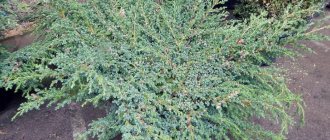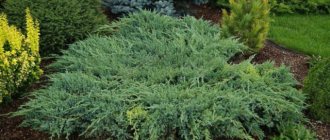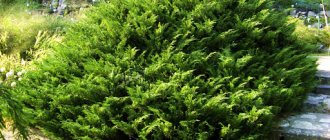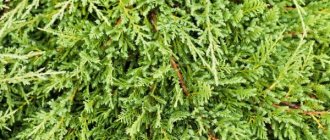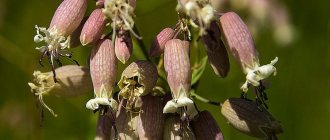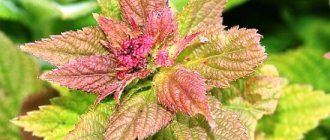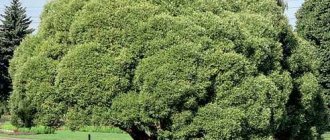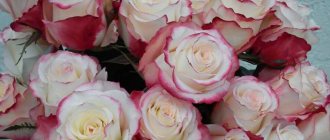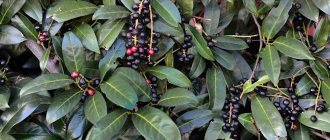Bushes and trees
0
367
Article rating
Kira Stoletova
The attractive evergreen juniper Old Gold was developed in 1958. A plant with a compact and spreading crown has become widespread in landscape design. Good frost resistance allows you to cultivate conifers in different climatic conditions.
Juniper Old Gold: a bright shrub for the garden
Description of juniper medium Old Gold
Medium juniper (juniperus pfitzeriana Old Gold) is a coniferous evergreen plant with a greater growth in width than in height. One of the most beautiful varieties of juniper with golden needles. The variety was obtained in Holland in the middle of the last century.
The long-growing shrub adds about 5-7 cm in height and 15-20 cm in diameter every year. By the age of 10 years, the height of the Old Gold juniper is 50 cm and the width is 1 m. Subsequently, the bush grows only in diameter, the maximum size of which can reach 3 m. Thus, in adulthood, the bush forms a symmetrical, flat and dense crown of bright color .
When grown in sunny areas, the needles acquire a golden hue, turning into a bronze color in cold weather. The needles are distinguished by their grace and retain a pleasant shade throughout the year.
Important! Growing horizontal Old Gold junipers allows you to purify the air from bacterial microflora within a radius of several meters, as well as drive away some insects.
When growing juniper, it is necessary to take into account that parts of the plant are poisonous; children or animals should not be allowed to pick them.
Growing rules
The timing of planting is affected by the type of seedling:
- with open roots they are planted at the end of April, at the beginning of May and in the last days of August;
- Plants purchased in a container or together with a ball of earth can be planted at any time of the year, with the exception of winter.
Selection of planting material
It is better to choose plants that are 2-3 years old. They already have a strong root system and a well-developed above-ground part, so they take root better after transplanting to a new location.
When choosing, you should pay attention not only to age, but also to general appearance:
- uneven color - the presence of yellow, red or black spots on the shoots of needles, as well as massive shedding of needles indicates an unhealthy condition;
- the bark should be of a uniform brown tone, without cracks, breaks, nodules or tubercles;
- if you purchase a bush with bare roots, inspect them for disease damage - rot indicates infection;
- healthy plants with an earthen lump do not contain traces of mold or acidification on the surface;
- You should not take specimens in which the root collar has bulges and is covered with plaque - they will develop slowly or will not take root at all in the new place.
It is better to buy planting material in a specialized store or nursery, where it is kept in optimally comfortable conditions. In addition, at such retail outlets you can purchase a real plant with all varietal characteristics.
Preparing the site and soil
Old Gold grows well in areas with access to sunlight. Therefore, it would be preferable to plant on the south side of the house, at a distance of at least 2.5 m from the wall, because in shading it loses its decorative effect and develops slowly.
You can plant conifers on any soil - loamy, sandy loam or nutritious black soil. The main condition is good drainage, high moisture and breathability.
The plant does not like stagnant moisture
Therefore, when planting on loam, add 2-3 buckets of sand or vermiculite; on sandy loam, add a couple of buckets of clay. Additionally, the area is sprinkled with humus and peat - 20 kg each. The number of components is calculated for an area of 1 m².
The plant loves slightly acidified soil, so the deacidification procedure in the garden bed is not carried out if its level does not exceed 7 units.
It grows poorly on waterlogged soil - the place must be deep, with groundwater flowing at least 1.5 m.
The best neighbors on the site are low-growing shrubs, rhododendrons, and azaleas. It is not recommended to plant near fruit, decorative and deciduous crops with a large and spreading crown. They will create unnecessary shading for the needles.
Landing technique
Medium juniper Old Gold loves space; when plantings are thickened, competition appears between bushes for moisture and nutrients, as a result of which they grow slowly and look faded.
The optimal distance for group planting is from 0.5 to 2 m, depending on the dimensions. The distance between rows is 1.5-2 m.
Planting holes are prepared two weeks before the planned move to the site. Their dimensions should be 2-3 times the length and width of the earthen ball, approximately 70x90 cm. Drainage is placed at the bottom of each hole to prevent moisture stagnation. Use crushed stone, pebbles or brick chips.
Then half is filled with a nutritious soil mixture of peat, sand and turf, mixed in a ratio of 2:1:1.
The roots are lowered without shaking off the earthen lump, then they are sprinkled with the remaining fertile soil, the soil around the trunk is trampled, and moistened at the rate of one bucket of water per plant. To avoid drying out of the soil and roots, mulch with peat or pine sawdust.
Juniper medium Old Gold in landscape design
In landscape design they are used in single and group plantings on lawns and in compositions with other plants. In container culture they are used to decorate balconies and loggias, in open ground - borders and flower beds.
Low-growing junipers are used to decorate the lower rows of coniferous corners with the participation of other evergreen crops, for example, pines and thujas, and other varieties of junipers. When planting a young plant in open ground, one should take into account the growth of the crown diameter of the Old Gold juniper by 2.5-3 m.
Advice! An ornamental shrub is suitable for placing in the rock garden, near artificial ponds and fountains.
Old Gold juniper is used in joint plantings with hydrangeas and heather. Bulb crops are planted in the rows of the juniper alley:
- tulips;
- hyacinths;
- gladioli;
- decorative bow.
Types and varieties of junipers (video)
All conifers used in modern landscape design are characterized by such an important feature as slow growth. The variety Juniperus chinensis Old Gold, which has very impressive golden needles, contrasts impressively with the emerald green of many ornamental plants. These shrubs are in great demand in landscape decoration. This variety of juniper is used not only in compositions, but also as tapeworms; the plants look great against the backdrop of lawns or a properly designed alpine hill. Medium juniper is perfect for creating a hedge. Proper care of plants will ensure the longevity of living decorative compositions.
Planting and caring for Chinese juniper Old Gold
Juniper Old Gold is planted in open, sunny areas. When growing in the shade, shrubs become shapeless, with a loose crown and lose their decorative qualities. Junipers are planted in places where melt and rain water do not linger.
The crop is unpretentious in terms of soil, but soils with weak or neutral acidity are preferred for planting. You can prepare light and loose, well-drained soil yourself and fill the planting hole with it. The soil mixture for planting is prepared from 2 parts peat and 1 part each turf soil and sand. You can also add forest juniper litter to the substrate.
Preparing seedlings and planting area
Young plants with a closed root system are watered before planting to make it easier to remove the earthen ball. The root system is sprayed with growth stimulants. For a single planting, prepare a hole several times larger than the earthen ball. For group plantings, dig a trench.
Advice! Young Old Gold junipers tolerate transplantation better than adult bushes.
A drainage layer of about 20 cm is poured onto the bottom of the planting hole. Sand, small stones or broken bricks are used as drainage.
Landing rules
Seedlings can be transplanted at any warm time, choosing a cloudy day. The plant is placed in the planting hole without deepening so that the root collar is 5-10 cm above the soil level.
After filling the planting hole, the soil is lightly pressed and an earthen roller is made around the tree trunk. This way, when watering, the water will not spread. After planting, pour a bucket of water into the root zone. In the next week, the juniper is also regularly watered. For better survival, the bush is shaded at first.
When transplanting a seedling from a place of temporary germination, it is necessary to observe the cardinal directions in which it grew before.
Watering and fertilizing
Old Gold juniper is drought-resistant, so it is watered several times during the dry season. For irrigation, use about 30 liters of water per plant. The shrub does not tolerate dry air well, so it must be sprayed once a week, in the evening.
Important! Juniper Old Gold is responsive to irrigation using the sprinkling method.
The crop needs fertilizing infrequently; it is enough to apply 40 g per 1 sq. m in mid-spring. m nitroammofoski or "Kemiry-universal", in the ratio of 20 g of the drug per 10 liters of water. Granular fertilizer is scattered around the tree trunk, covered with a small layer of soil and watered. Organic fertilizers are not used for fertilizing. Manure or bird droppings cause burns to the root system.
Mulching and loosening
Surface loosening is necessary for young junipers; it is carried out together with weeding and after watering. Mulching the soil helps protect the roots from overheating and has a decorative function. Tree bark and wood chips, stones, and nut shells are used for mulch. The protective layer is poured 5-7 cm high.
Trimming and shaping
The plant does not require regular pruning. But the shrub lends itself well to formative pruning, which is carried out 1-2 times a year. Formative pruning becomes especially necessary when growing Old Gold juniper in containers. In spring, remove broken shoots.
When pruning shoots, it is necessary to use protective equipment so that the juice or resin of the plant does not get on the mucous membrane. Because parts of the plant contain toxic compounds.
Preparing for winter
The frost resistance of Old Gold juniper allows it to be left for the winter without shelter. But young, small-sized Old Gold juniper is recommended to be protected. To do this, the tree trunk circle is insulated with a thick layer of sawdust or peat. When there is little snow cover, the crown is covered with spunbond. In order to protect the uncovered crown from sunburn in early spring, plants are shaded with screens.
In the spring, snow from the Old Gold juniper must be swept away so that when it melts, it does not break the shoots and create stagnant moisture. After the snow melts, the old mulch is removed from under the bush and new mulch is added.
Wintering juniper Old Gold in an apartment
The description of coastal juniper Old Gold states that it can be grown in container culture. To prevent the root system in the containers from freezing in the winter, the plants are brought indoors. But in winter it is necessary for the plant to be at rest, so the temperature should not be high. A warm loggia is well suited for wintering. During bright sunshine, it is necessary to have the possibility of shading so that the plant does not overheat.
Landing
The juniper of the described variety does not have strict planting requirements. It takes root well in almost any climatic conditions and can tolerate low air temperatures and short-term drought . However, in order to obtain a shrub with high decorative properties, experts advise paying special attention to the planting process.
Video: Planting and caring for juniper
Selection and preparation of a site
Old Gold belongs to the category of light-loving plants that grow well in sunny, well-lit areas, reliably protected from drafts and cold winds. When growing a shrub in the shade, it loses its decorative qualities and becomes shapeless and faded. As for the soil, the plant does not have high demands on it. The best option for it would be light, air- and moisture-permeable soils with a weak or neutral acidity level.
Propagation of juniper pfitzeriana Old Gold
Decorative forms of juniper are propagated by cuttings. Planting material is taken only from adult 8-10 year old bushes. In early spring, cuttings about 10 cm long are cut, the lower part of which should have lignification. The bottom of the cutting 5 cm is freed from needles and soaked in growth stimulants.
Further rooting occurs in planting containers filled in equal parts with a mixture of sand and peat. It takes about a month for the root system to develop. After this, the seedling is transferred to open ground, where it is left for the winter, covered with spruce branches. So, the plant is grown for several years, and then it is transplanted to a permanent place of growth.
Pests and their control
Spider mite. You can destroy the juice-sucking insect using Actellik or Aktara.
Aphid . In a short time it can lead to the death of the conifer; use garlic, tobacco or onion infusion, ash-soap solution. At an advanced stage, pesticides are used - Confidor, Karate or Fundazol.
Shield. The drug Decis will help you get rid of it. Irrigate the crown and tree trunk area twice in the evening at intervals of 7 days.
To prevent diseases and pests, it is necessary to spray the soil with copper sulfate every fall, then carry out deep digging.
Diseases and pests of juniper media Old Gold
Juniper (juniperus media Old Gold) is disease resistant and is rarely attacked by pests. But after wintering, weak plants may suffer from desiccation and sunburn, and become infected.
Rust infection in juniper most often occurs when growing near pome fruit trees - plants that are intermediate hosts of fungal formations. The affected areas are cut out and burned. To prevent other fungal diseases, spring preventive spraying is carried out with fungicides or preparations containing copper.
When anthills are close together, aphids appear on the juniper. Insects especially harm young shoots, inhibiting their development. Aphids are washed off from infested areas with water or soap solution, covering the roots from liquid soap. The procedure is carried out until the parasites completely disappear.
Spider mites appear on the bush during the dry period. A cobweb appears at the site of the lesion, the needles turn brown and then fall off. To prevent the appearance of insects, juniper must be periodically sprayed to increase air humidity. For large areas of infection, acaricides are used.
Features of care
Strict adherence to growing technology and proper care allow you to get a healthy, durable and beautiful plant. Caring for the plant is not difficult and requires following the following recommendations:
- it is necessary to remember that junipers absolutely cannot tolerate excess moisture, and excessively abundant and frequent watering can cause disease and rotting of the root system;
- watering should be carried out during the dry period, but no more than two or three times during the entire growing season;
- juniper bushes should be pruned very carefully, due to the slow growth and long recovery of the plant;
- All dry branches, as well as branches that interfere with the full growth of the bush, must be removed;
- When forming a hedge, it is necessary to carefully but carefully remove all protruding shoots.
Despite the fact that this popular representative from the Cypress family has fairly high frost resistance, seedlings must be covered for the winter in the first year of planting.
What are the criteria for choosing planting material?
When purchasing juniper seedlings, pay attention to all parts of the plant. The needles should not be overdried and fall off. Check the branches - in a healthy seedling they are flexible and not brittle. Inspect the entire bush for fungus and mold.
Important point. When purchasing, ask how the Old Gold seedling was grown - in the same container or whether it was placed there the day before the sale.
All types of junipers do not like transplanting, so container seedlings have the best chance of taking root.
If the roots are not damaged, do not stick out, and the needles look fresh, you have a high-quality juniper seedling.
If the root system is open, broken roots are visually noticeable, then such a bush will have difficulty taking root or will die altogether.
Watering, loosening
It is recommended to water the plants by sprinkling.
There is no particular need to feed such plants too often. In the middle of spring, approximately forty grams of Kemira-universal should be applied per square meter. You can also use nitroammophoska for these purposes. Twenty grams of product should be consumed per ten liters of water. If the fertilizer is in the form of granules, then you just need to scatter it in the tree trunks of the plants. After this, a little soil is poured on top and watered. It is not recommended to use organic matter as fertilizers, as they can burn the juniper root system. This is especially true for bird droppings and manure.
From time to time, while the plants are still young, it is necessary to loosen the soil. There is no need to loosen the soil deeply, as there is a risk that the surface roots may be damaged. This procedure can be combined with weed removal. It is best to do this after watering the junipers. It would not be superfluous to lay a mulch layer, so the juniper root system will not overheat and the moisture will not evaporate so quickly. For these purposes, tree bark, wood chips, nut shells, and pebbles are usually used. The mulch layer should be approximately five to seven centimeters.
There is no need to prune junipers on a regular basis. However, it is possible to form a bush once or twice a year. This care requirement especially applies to those plants that grow in containers or other containers. In spring, it is necessary to remove branches that have been broken or damaged. When pruning stems, be sure to use protective equipment. Droplets of juice or resin should not get on the skin or mucous membrane, as the plant contains toxic substances.
This variety of juniper can withstand low temperatures very well, so it is not necessary to snatch it for the winter. However, if the plant is still young, then it will require additional shelter for the winter. For these purposes, peat or sawdust should be placed in the tree trunk area. The layer should be thick enough. If the winter is not too snowy, then the crowns of the plants are pulled out using spunbond. There is a risk that the early spring sun can harm the needles, so at the beginning of the spring it is better to shade the plants using screens. In spring, you also need to remove snow from the plants, since after it melts, there is a risk that the stems will break and the moisture will begin to stagnate. After the stitch has melted, you need to replace the old mulch layer with a fresh one.
If you grow Chinese juniper Old Gold in containers, then they need to be brought indoors for the winter. Otherwise, the roots may freeze. Juniper “rests” in winter, and therefore it should not be too warm in the room where the juniper is located. For these purposes you can use a loggia or balcony. In case of bright sun, provide the plants with shaded conditions.
Trimming
In order for the plant to decorate the garden all year round, it requires pruning. Dry, diseased and broken branches need to be removed. Be extremely careful - the plant will take a long time to recover.
It is generally accepted that it is necessary to form the crown of coniferous plants in the summer. But in the case of Old Gold juniper, this can worsen its condition. The fact is that a plant trimmed in the second half of summer simply will not have time to get stronger before the onset of cold weather. Any pruning is a serious stress for shrubs of this variety, and therefore, before picking up the scissors, it is important to make sure that the plant is healthy and ready for the procedure.
If you decide to form a living juniper hedge, remove all protruding shoots. This must be done carefully, but extremely carefully. In order for juniper to recover faster after pruning, it is necessary to treat it with preparations containing copper.
